Air cons in Singapore are available as window and split air conditioners. Window air cons are installed near windows, and multi split air conditioners are placed in different rooms and can be controlled separately. In such warm weather, an air conditioner has slowly become more of a need than a want. But which is the best unit to choose?
There are many considerations and the new homeowner can be forgiven for giving up and choosing to buy a fan instead. In this article, I’ll demystify the process for you. If the technical terms wear you down, just go straight to the nifty table at the end of this article. Cut it out and bring it along with you when you choose your air conditioner!
What to look out for when choosing an air con:
1 What is your room size?
Both window and split air conditioners come in various sizes and energy-saving ratings. In order to cool the air efficiently, you need to use the standard measurement of BTU and choose the right air con size. BTU is the standard to measure the cooling capacity of an air con for a particular area.
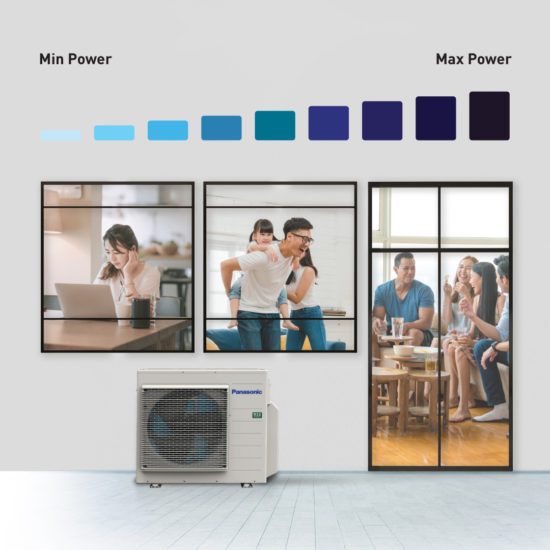
Image by Panasonic
Calculating the BTU required to properly cool the area is a simple process. The first step is to multiply the width of the room with its length. When you have the correct answer, you should multiply it with 25 BTU. Most split air-conditioner units will have their BTU levels at 9,600-14,000 BTU. Systems like the Panasonic Inverter series are sufficient for a 3-room HDB flat if you are not placing the air con unit anywhere near a window.
When you use an appropriate size air conditioner, it makes sure you enjoy the cool air and excess moisture is extracted from the room. Contrary to popular belief, an air-con with a larger BTU will not cool the area quickly and may make you feel even warmer since it cannot suck out excess moisture fast enough. Proper usage will also lead to lower energy bills.
2 Calling Systems 1, 2, 3, 4
You may have looked at an air-con catalogue and seen air-con units such as the Panasonic System 1 Air Con. What do the numbers mean?
Simply put, the figure means the number of indoor units to 1 outdoor unit.
For example, a System 4 will be 4 indoor units to 1 outdoor unit. So if you have a 3 bedroom unit, you may want to invest in a System 3 split air conditioner to cool your entire house. A System 4 air con would be useless to your house as its capacity would far exceed what your house requires.
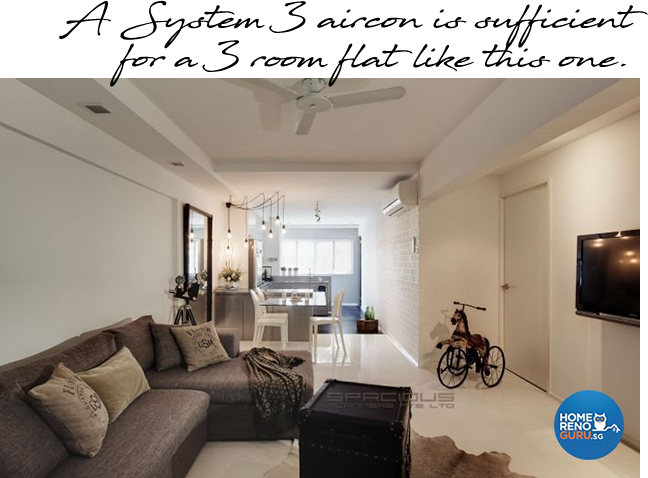
HDB 3 ROOM by Spacious Planners
3 Is my air con energy efficient?
There are many brands of air conditioners available, and you need to check which the most energy-efficient unit out there is. Choosing the right one means saving on electricity costs as well as saving the environment! First, you’ll need to understand that there are different types of air-con fluid used.
Refrigerant (or gas) is the working fluid for air-conditioners: R22 or R410A are their names. R22 is usually used but is gradually phased out. You may still see R22 air conditioners in the shops so buyers beware: switching to R410A is the better option.
R410A is more energy-efficient and environmentally friendly in comparison. It causes lesser damage to the ozone layer, and also requires a slightly stricter installation procedure, so those handling R410A must be trained. If you recall seeing advertisements with catchy slogans of “energy-efficient”, this is what it’s all about. There are also air-con units such as the Daikin ENVi (short for Environment) series which uses the even newer R32 refrigerant to cool your house. The new R32 gas causes minimal damage to the ozone layer and cools your house more efficiently.
4 What are the installation materials used for the air conditioner?
Before you consider the installation materials, it is vital to understand terms like air con condensation, and what it means when your contractor says your air con is sweating. Condensation or ‘sweating’ happens around the trunk (plastic casing that encases the copper pipes, PVC drainage pipes and wiring) of your air-con. This is actually quite normal but if the insulation material and piping are inferior, condensation will happen at an alarming rate! To prevent rain indoors, the correct insulation and pipes must be used.
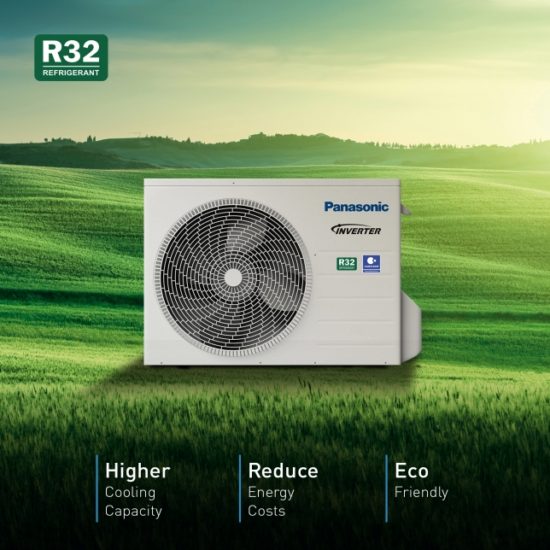
Image by Panasonic
Insulation is the material used to cover the copper pipe, usually rubber foam, which helps to absorb water droplets formed due to condensation on the copper pipes when the air-conditioner is operating. Inferior insulation will result in a higher condensation rate and cause leakages. Insist on ⅜ inches for the piping in trunking (plastic casing that encases the copper pipes, PVC drainage pipes and wiring) and ½ inches for piping that can be easily hidden by false ceilings or concealed in walls. Any inch less and your air con may leak as a ¼ inch pipe gets choked easily!
You also need to decide on the copper pipe. Generally, a thicker copper pipe is able to withstand higher operating pressure. For HDB owners, copper piping of 0.61mm thickness is usually recommended. If you have concealed piping, then 0.71mm is a better option. Another thing you should take note of is the bending of the copper piping. To lower the odds of condensation or poor refrigerant flow (which will make the air-conditioner less cold), make sure that the piping is bent.
Installers generally use one of 2 sizes of PVC drainage pipes available in the market: 13mm and 16mm (referring to the pipe’s internal diameter). Using a bigger size will mean that the air-conditioner is able to drain water faster and slow down the possibility of leakage.
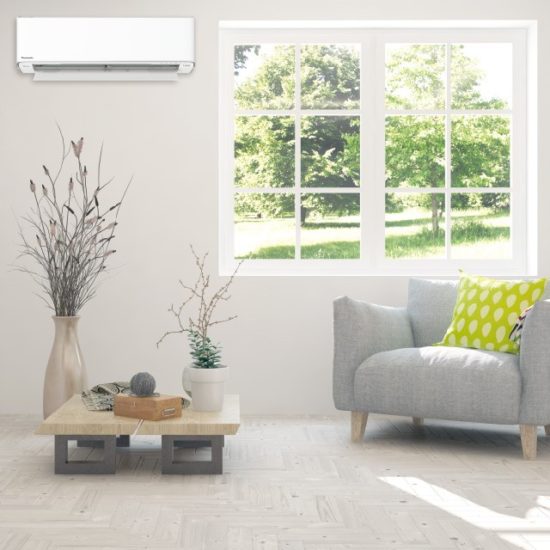
Image by Panasonic
5 To invert or not to invert?
For non-invertor air conditioners, the compressor and its motor are manufactured to operate at one constant speed only. In simple terms, when the room reaches the pre-set temperature, the compressor will stop working. And when it senses an increase in temperature, it will start running again. The drawback of this system is that more electricity will be consumed as more power is needed to start the system all over again whenever it stopped. In addition, the compressor will also have a shorter life span.
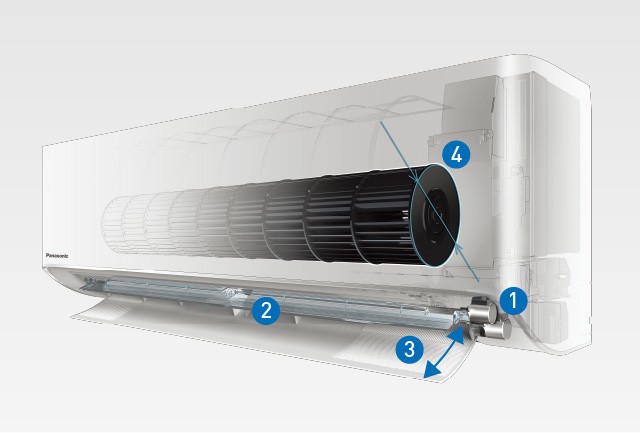
Image by Panasonic
For owners that do not use the aircon regularly, it may be more worthwhile getting a non-invertor air conditioner. But if you need to be in a cool area most of the time, then an inverter air conditioner suits you best. The Mitsubishi Starmex range or the Panasonic Inverter series are potential candidates to choose from. After an inverter air conditioner attains the set temperature, instead of ‘switching off’ like a non-invertor, it uses the minimum power to ensure your room is still at the required temperature and adjusts smoothly in response to any changes in the cooling load. Overall, you use less electricity.
While an inverter air con costs more (about $600-$800) than a non-invertor, the payoff is worth it as an Invertor is more energy efficient. Inverters are generally quiet compared to non-inverters and can help you save money in the long run.
6 Choosing the installation company.
When choosing an air-con company to install the air-con for you, the number of years the company is in business and the projects they are involved in (such as installing air-con units for schools) will help you to see if they are reliable installers.
The flat owner is responsible for the proper installation, safety and stability of the air conditioner. If your flat does not have an air-con ledge, a stainless steel bracket has to be mounted to support the condensing unit. This is because the condensing unit is a safety hazard if it falls off as a result of improper installation by a non-qualified installer. A Building and Construction Authority (BCA) certified installer will wear a safety belt when installing the condensing unit for a flat requiring a stainless steel bracket to support the condensing unit. Therefore, you will need to engage a BCA-trained installer to install flats which require a stainless steel bracket.
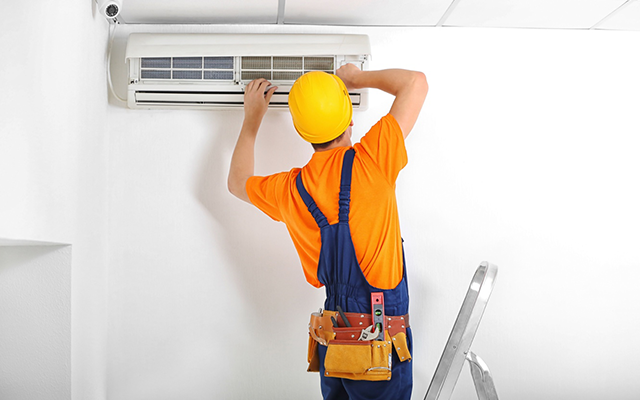
Image by SHUTTERSTOCK
Also, do check if the company uses its own installers or outsources the installation. Having a team of in-house installers means that the price you will be paid does not incur a third-party cost which translates to better savings. It is also easier if the company uses an in-house installer as the same installer can return to do any rectification work.
As far as installation warranty is concerned, getting an extended warranty for your air conditioner is crucial as you can have peace of mind when your air conditioner breaks down suddenly and it can prevent others from overcharging you for any repair work rendered. And lastly, prevention is better than cure. You will want to check if the company provides regular servicing.
When the unit is not overworked and properly maintained, the life span of the air conditioner can be extended.
With these five tips in mind, we hope you have a better understanding of air condition units and can choose the best one for your house needs!
Still Confused? Here’s a quick summary!
|
ROOM SIZE |
CALLING SYSTEMS 1,2,3,4 |
IT IS ENERGY EFFICIENT |
INSTALLATION MATERIALS |
TO INVERT OR NOT TO INVERT |
INSTALLATION COMPANY |
|
| COMMON TERMS | BTU: the standard to measure the cooling capacity of an aircon for a particular area. In simple terms, it’s a unit of power. 1 Watt is around 3.41214 BTU.
The width of the room x length x25 BTU will give you the correct BTU for your room. |
Simply put, the figure means the number of indoor units to 1 outdoor unit. For example, a System 4 will be 4 indoor units to 1 outdoor unit. | Refrigerant (or gas) is the working fluid for air-conditioners. R22 or R410A is usually used but R22 is being gradually phased out. R410A is more energy-efficient and environmentally friendly in comparison. | Trunk: the plastic casing that encases the copper pipes, PVC drainage pipes and wiring) of your air-con.
Insulation: material used to cover the copper pipe, usually rubber foam. Sweating describes air conditioner condensation, which is common around the trunk. |
Non-inverter: After an inverter air conditioner attains the set temperature, instead of ‘switching off’ like a non-invertor, it uses the minimum power to ensure your room is maintained at the required temperature and adjusts smoothly with response to any changes in the cooling load. | A Building and Construction Authority (BCA) certified installer is the requirement to look out for when you choose a company for installation. |
| Why is this important? Or What are some questions you may want to ask? | When you use an appropriate size air conditioner, it makes sure you enjoy the cool air and excess moisture is extracted from the room. | If you live in a 2 bedroom apartment, it will not make sense to get a System 4 unit which is more expensive and its potential is not fully utilised! | R410A is:
The parts that are used to hold the R410A fluid do not vibrate as much and so are quieter. |
Consider if you are going to hide the installation materials or not before choosing the size of the piping: ½ inches is preferred for piping that will be hidden by false ceilings or concealed in walls instead of being encased in a trunk.
Wiring: For HDB owners, the G23 (0.61mm) is usually recommended. If you have concealed piping, then G22 (0.71mm) is a better option. |
A non-invertor is much preferred over an inverter as it is more energy efficient in the long term, keeps your room cool without switching off and is quieter. The plus for an inverter is that it is cheaper to install. |
|
| POTENTIAL UNITS | Mitsubishi Starmex Series | Panasonic System 1/2/3/4 series | Daikin ENVi series | Panasonic Inverter series or LG Artcool Aircon range |

NEW TO RENOVATION?
Get a FREE e-copy of our comprehensive renovation guide when you sign up for our newsletter.


